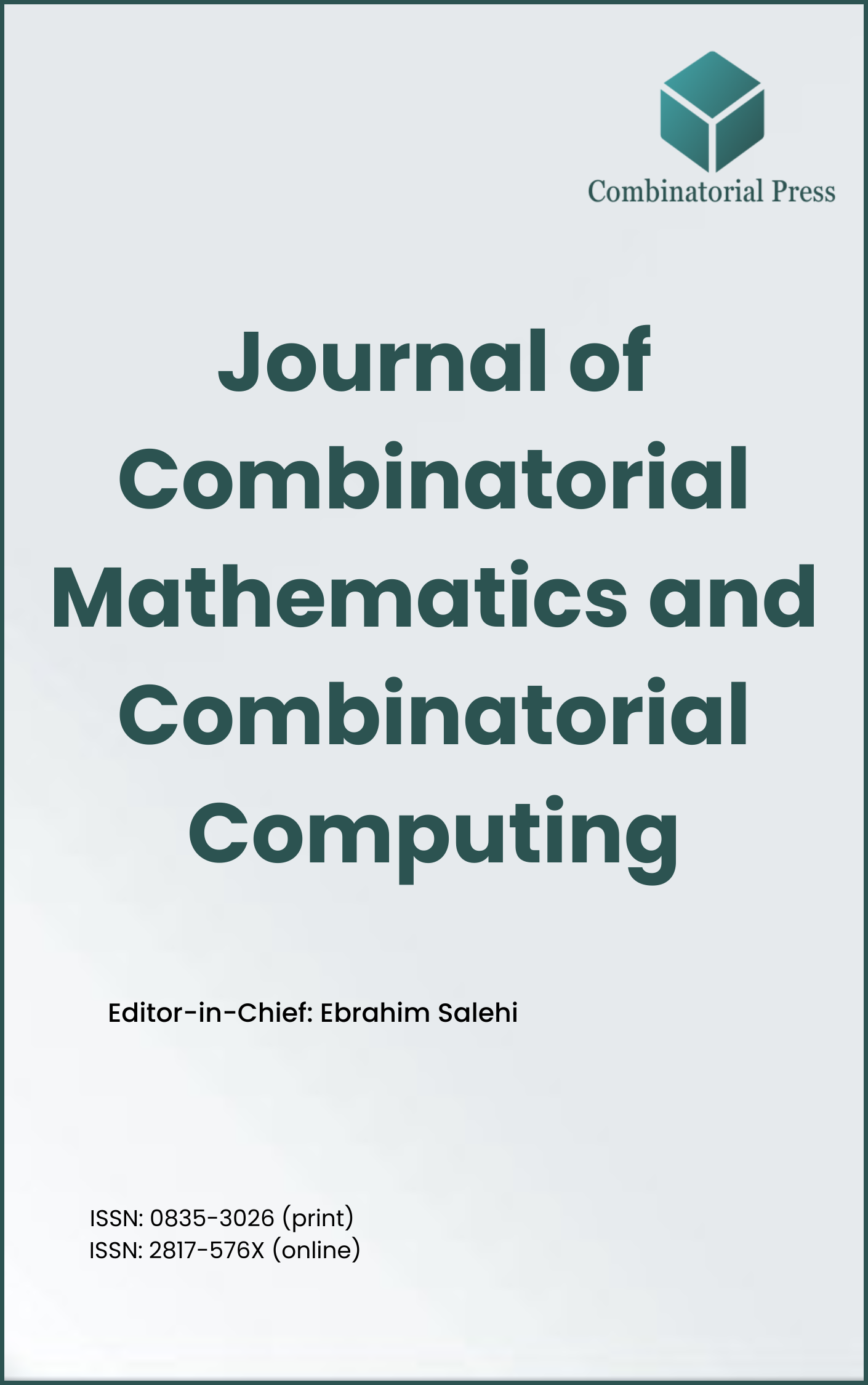
Journal of Combinatorial Mathematics and Combinatorial Computing
ISSN: 0835-3026 (print) 2817-576X (online)
The Journal of Combinatorial Mathematics and Combinatorial Computing (JCMCC) embarked on its publishing journey in April 1987. From 2024 onward, it publishes four volumes per year in March, June, September and December. JCMCC has gained recognition and visibility in the academic community and is indexed in renowned databases such as MathSciNet, Zentralblatt, Engineering Village and Scopus. The scope of the journal includes; Combinatorial Mathematics, Combinatorial Computing, Artificial Intelligence and applications of Artificial Intelligence in various files.
- Research article
- Full Text
- Journal of Combinatorial Mathematics and Combinatorial Computing
- Volume 003
- Pages: 183-194
- Published: 30/04/1988
We show that there are \(1281\) non-isomorphic residual \((16, 24, 9, 6, 3)\)-designs.
- Research article
- Full Text
- Journal of Combinatorial Mathematics and Combinatorial Computing
- Volume 003
- Pages: 169-181
- Published: 30/04/1988
The cycle rank, \(r(G)\), of a graph \(G = (V, E)\) is given by \(r(G) = |E| – |V| + 1\). Let \(f(k, r)\) be the minimum number of cycles possible in a \(k\)-connected graph with cycle rank \(r\). We show \(f(1, r) = r\), \(f(2, r) = \binom{r+1}{2}\), \(f(3, r) = r^2 – r + 1\) and characterize the extremal graphs. Bounds are obtained for \(f(k, r)\), \(k \geq 4\); the upper bound is polynomial in \(r\).
- Research article
- Full Text
- Journal of Combinatorial Mathematics and Combinatorial Computing
- Volume 003
- Pages: 163-167
- Published: 30/04/1988
We prove that for any odd positive integer \(n > 1\) and for any sufficiently large integer \(v > v_0(n)\), there exists a Nested Steiner \(n\)-Cycle System of order \(v\) if and only if \(v \equiv 1 \pmod{2n}\). This gives rise to many new classes of perpendicular arrays.
- Research article
- Full Text
- Journal of Combinatorial Mathematics and Combinatorial Computing
- Volume 003
- Pages: 153-162
- Published: 30/04/1988
In this paper, we examine the concept of cohesion, which was first introduced in \([2]\) and further studied in \([5]\). Our purpose is to consider the global effects on cohesion when an edge is deleted from a given graph. The earlier paper dealt with such effects when an edge was added, and then in a local sense. After some preliminary discussions and definitions, we move on to display graphs that are “nearly stable” under edge deletion and to further discover an infinite class of \(2\)-connected graphs that are indeed “stable”. This result is followed by some discussion of graphs that have more than one block.
- Research article
- Full Text
- Journal of Combinatorial Mathematics and Combinatorial Computing
- Volume 003
- Pages: 135-151
- Published: 30/04/1988
Let \(V\) be a set of \(v\) elements. Let \(G_1, G_2, \ldots, G_m\) be a partition of \(V\) into \(m\) sets. A \(\{G_1, G_2, \ldots, G_m\}\)-frame \(F\) with block size \(k\), index \(\lambda\) and latinicity \(\mu\) is a square array of side \(v\) which satisfies the properties listed below. We index the rows and columns of \(F\) with the elements of \(V\). (1) Each cell is either empty or contains a \(k\)-subset of \(V\). (2) Let \(F_i\) be the subsquare of \(F\) indexed by the elements of \(G_i\). \(F_i\) is empty for \(i = 1, 2, \ldots, m\). (3) Let \(j \in G_i\). Row \(j\) of \(F\) contains each element of \(V – G_i\) \(\mu\) times and column \(j\) of \(F\) contains each element of \(V – G_i\) \(\mu\) times. (4) The collection of blocks obtained from the nonempty cells of \(F\) is a \(GDD(v; k; G_1, G_2, \ldots, G_m; 0, \lambda)\). If \(|G_i| = h\) for \(i = 1, 2, \ldots, m\), we call \(F\) a \((\mu, \lambda, k, m, h)\)-frame.
Frames with \(\mu=\lambda=1\) and \(k = 2\) were used by D.R. Stinson to establish the existence of skew Room squares and Howell designs. \((1, 2; 3, m, h)\)-frames with \(h = 1, 3\) and \(6\) have been studied and can be used to produce \(KS_3(v; 1, 2)s\). In this paper, we prove the existence of \((2, 4; 3, m, h)\)-frames for \(h = 3\) and \(6\) with a finite number of possible exceptions. We also show the existence of \((2, 4; 3, m, 1)\)-frames for \(m \equiv 1 \pmod{12}\). These frames can be used to construct \(KS_3(v; 2, 4)s\).
- Research article
- Full Text
- Journal of Combinatorial Mathematics and Combinatorial Computing
- Volume 003
- Pages: 121-134
- Published: 30/04/1988
We give a brief account of some recent results on edge-colouring simple graphs and of some recent results on the total-chromatic number of simple graphs. We illustrate the kind of arguments which have been found to be successful by proving one of the simpler results on edge-colouring graphs, and by showing how to apply this to obtain one of the recent results on the total-chromatic number.
- Research article
- Full Text
- Journal of Combinatorial Mathematics and Combinatorial Computing
- Volume 003
- Pages: 105-119
- Published: 30/04/1988
The question of whether all \(B[k,t;k^2]\) designs are \(t\)-resolvable is answered in the affirmative for \(k=3\) and \(t=3\), when the design has no repeated blocks. It is further shown that all such \(B[3,3;9]\) designs are also \(2\)-resolvable.
- Research article
- Full Text
- Journal of Combinatorial Mathematics and Combinatorial Computing
- Volume 003
- Pages: 97-104
- Published: 30/04/1988
- Research article
- Full Text
- Journal of Combinatorial Mathematics and Combinatorial Computing
- Volume 003
- Pages: 93-96
- Published: 30/04/1988
A binary code has bounded synchronization delay if there exists an integer \(s\) such that at most \(s\) consecutive bits are required to establish word synchronization in any message. The code whose words are lexicographically least in the non-periodic orbits determined by cyclic permutation of all words of length \(n\) is called the canonical bounded synchronization delay code. It has the maximal number of words possible in a synchronizable code of fixed word length. Any code of fixed word length \(n\) can be represented as a set of vertices in the \(n\)-cube. We prove that the canonical bounded synchronization delay code is a connected subset of the \(n\)-cube.
- Research article
- Full Text
- Journal of Combinatorial Mathematics and Combinatorial Computing
- Volume 003
- Pages: 71-91
- Published: 30/04/1988
A degree sequence which is realisable by a \(3\)-uniform hypergraph is called \(3\)-graphic. Seven necessary conditions, one sufficient condition, and one equivalent condition for degree sequences to be \(3\)-graphic are derived. Moreover, four special classes of degree sequences are examined. For each class an equivalent condition for the sequences in this class to be \(3\)-graphic is derived. Using these conditions, all the \(3\)-graphic degree sequences of length at most seven have been determined.





